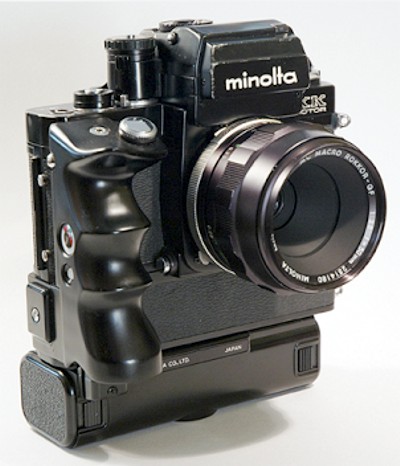
MINOLTA MOTOR DRIVES & AUTOWINDERS

Minolta -- and others -- made several motor drives and autowinders for many of Minolta's SLR cameras -- but not all of them ended up being marketed. Each motor drive or autowinder will only fit on certain cameras -- see below.
Some of the details are lost to history. Here's what we know -- in chronological order:
In the late 1950's competition in the new 35mm SLR arena was intense, and Minolta wanted to get in the game -- but to compete in the marketplace, it was important to have all the features that consumers wanted. Minolta introduced it's first SLR, the SR-2, in 1958, and it have an enormous amount of accessories. One of these was a detachable motor drive.
The less expensive SR-1 which appeared a year later also included connections for the motor drive -- although this was dropped from the later versions of the SR-1.
And apparently some of the initial, more advanced, SR-3 cameras of 1960 retained the motor drive connections.
The motor drive was even listed in early Minolta sales brochures, but unfortunately it never made it to market -- along with several other accessories and lenses.
In the mid 1960's competition in the 35mm SLR arena was still intense, and now for Minolta to compete in the marketplace, it needed an SLR with TTL metering. It produced the SR-7 in 1963, but the built-in meter was not a TTL meter. Minolta developed a prototype SLR with "stop-down" TTL metering, but thankfully it was never marketed. Dubbed the SR777, it looked much like the earlier Minolta SLR cameras except that it had a new STOP-DOWN metering button -- and a built-in motor drive. Thankfully, Minolta was wise enough not to go down this photographic dead-end, and introduced a full-aperture, meter-coupled TTL system the next year -- the SRT101 in 1966!
Minolta understood that many photographers wanted a motor-driven camera, and in 1970 they marketed one -- the SR-M. Although it looked like the SRT 101 of 1966, it was different in several ways. While it came with a built-in motor-drive and included a mirror lockup, it lacked a meter, DOF button, and a self-timer. The motor drive was permanently attached, and the handle on the side held the batteries that powered the motor.
In 1972, Minolta shook the photographic world when it introduced the XK. It had everything a professional photographer could want -- except a motor drive. So in 1976, Minolta produced an XK with a motor drive. Unfortunately, it was permanently attached to the camera.
In 1977, Minolta again shook the photographic world with the first multiple-mode exposure system SLR. This time they added a compact, easy-to-attach (and remove) motor drive. The Autowinder D required four AA batteries, and provided up to two frames per second film advance -- and works on any of the XD cameras.
Later in the same year, Minolta introduced the Autowinder G for it's less expensive XG-7 camera. Identical in apperance to the Autowinder D, but NOT interchangeable, it required four AA batteries, and provided up to two frames per second film advance -- and works on any of the XG, or later, cameras (X-700, X-570, X-370, etc.).
At some point, Minolta came out with a slightly modified Autowinder G, labeled the Autowinder GP. The only change is that the GP has a small extension that fits into the camera's battery chamber -- to power the camera, as well as the autowinder. Some people find this a convenience, while others find it a nuisance because you have to find a place to store the tiny, easy-to-lose, battery chamber cover. The Autowinder GP is hard to find, while the standard Autowinder G is easy to find -- at ridiculously low prices.
With the introduction of the Minolta XG-M (Minolta's final XG model), Minolta introduced a removable motor drive -- that's what the "M" in XG-M refers to. It's capable of up to 3.5 frames per second film advance. It will also work on several later Minolta models, such as the X-700, X-570, X-7A, X-9, etc.
A company in Hong Kong produced autowinders for several SLR cameras during the 1980s, and one was for Minolta XG cameras. They varied in features, and were sold under different labels, such as Kalimar.
In addition, Seagull introduced several autowinders for their numerous Minolta X-370 clones. They varied in features, and were sold under different labels, such as Seagull, Phoenix, Centon, etc.

RETURN TO THE MANUAL MINOLTA HOME PAGE
COPYRIGHT@1995-2025 by Joe McGloin.
All Rights Reserved. The material on this website is protected by US Federal copyright laws. It cannot be copied
or used in any manner without specific approval from the owner.